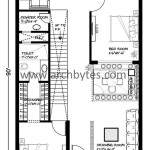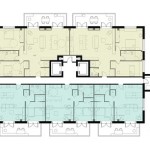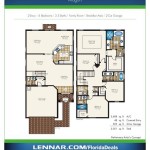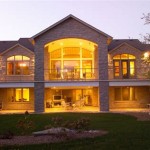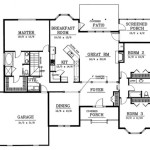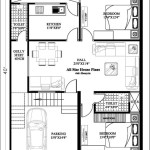Understanding Pod Style Floor Plans: A Modern Approach to Spatial Design
Pod style floor plans represent a significant departure from traditional open-plan or cellular office layouts. Instead of relying on large, undivided spaces or walled-off individual offices, the pod system emphasizes modularity and flexibility, creating self-contained units or "pods" within a larger framework. These pods can serve a variety of purposes, from individual workstations to small meeting rooms, collaborative project hubs, or even quiet focus areas. Understanding the principles and benefits of pod style floor plans is crucial for businesses and organizations seeking to optimize their space utilization, enhance employee productivity, and adapt to evolving workplace needs.
The core concept revolves around creating these distinct, enclosed or semi-enclosed spaces that address specific functional requirements. These pods are not permanent fixtures; they can be reconfigured or relocated with relative ease, allowing organizations to adapt to changing team structures, project demands, and technological advancements. This adaptability is a key differentiator compared to more rigid floor plan designs and makes pod style layouts an attractive option for dynamic and rapidly evolving environments.
The design of a pod is crucial to its effectiveness. Considerations include acoustics, lighting, ventilation, and visual privacy. A well-designed pod should offer a comfortable and productive environment for its occupants while minimizing distractions for those working in adjacent areas. The materials used in pod construction also play a vital role, influencing both the aesthetic appeal and the acoustic performance of the space. Furthermore, integration with existing infrastructure, such as power and data cabling, is essential for seamless functionality.
While often associated with office environments, the applications of pod style floor plans extend beyond the commercial sector. Educational institutions, healthcare facilities, and even residential spaces can benefit from the modularity and adaptability offered by this design approach. In schools, pods can create small group study areas or dedicated spaces for focused learning. In hospitals, they can provide private consultation rooms or quiet zones for staff. In residential settings, they can delineate functional areas within open-plan living spaces, creating distinct zones for work, relaxation, or entertainment.
Key Point 1: Enhanced Flexibility and Adaptability
The primary advantage of pod style floor plans lies in their inherent flexibility. Traditional office layouts, whether open-plan or cellular, often require significant and costly renovations when organizational needs change. Reconfiguring walls, moving electrical outlets, and adjusting HVAC systems can be disruptive and time-consuming. Pod systems, on the other hand, offer a far more agile solution. Individual pods can be easily relocated, added, or removed to accommodate changing team sizes, project requirements, or technological upgrades. This adaptability allows organizations to optimize their space utilization dynamically, ensuring that the layout always aligns with their current operational needs.
Furthermore, the modular nature of pods allows for phased implementation. Instead of undertaking a complete office overhaul, organizations can introduce pods incrementally, testing different configurations and assessing their impact on employee productivity and satisfaction. This iterative approach minimizes disruption and allows for continuous improvement, ensuring that the final layout is optimized for the specific needs of the organization. This flexibility also extends to the aesthetic realm, as pods can be customized with different finishes, colors, and materials to reflect the organization's brand identity and create a visually appealing workspace.
The ability to adapt quickly to changing circumstances is particularly valuable in today's rapidly evolving business landscape. New technologies, evolving work styles, and unforeseen events, such as the recent shift towards remote work, can necessitate significant adjustments to office layouts. Pod style floor plans provide the agility to respond to these changes effectively, ensuring that the workspace remains functional and supportive of the organization's goals.
Key Point 2: Improved Acoustic Performance and Privacy
One of the key challenges associated with open-plan offices is the lack of acoustic privacy and the potential for distractions. The constant noise and activity can make it difficult for employees to concentrate and can negatively impact productivity. Pod style floor plans address this issue by providing enclosed or semi-enclosed spaces that offer a greater degree of acoustic isolation. The walls and ceilings of the pods can be constructed from sound-absorbing materials, such as acoustic panels or specialized insulation, to minimize noise transmission and create a quieter and more focused work environment.
The level of privacy offered by a pod can be tailored to the specific needs of the user. Some pods may be fully enclosed, offering complete visual and acoustic isolation for tasks that require intense concentration. Others may be semi-enclosed, providing a degree of privacy while still allowing for interaction with colleagues. The choice of pod design will depend on the nature of the work being performed and the preferences of the individual employee. For example, a pod designed for phone calls or video conferencing would typically require a higher level of acoustic isolation than a pod used for collaborative brainstorming sessions.
In addition to acoustic privacy, pods can also provide visual privacy, which can be particularly important for sensitive discussions or confidential work. Opaque or frosted glass panels can be used to obscure visibility while still allowing natural light to penetrate the space. This combination of acoustic and visual privacy can create a more comfortable and productive work environment, reducing distractions and allowing employees to focus on their tasks.
Key Point 3: Enhanced Collaboration and Teamwork
While pod style floor plans offer enhanced privacy and focus, they can also be designed to foster collaboration and teamwork. Pods can be configured as small meeting rooms or project hubs, providing dedicated spaces for teams to work together on shared projects. These collaborative pods can be equipped with whiteboards, presentation screens, and other tools to facilitate communication and brainstorming. The enclosed nature of the pod helps to minimize distractions and create a more focused environment for team discussions.
The strategic placement of pods can also encourage spontaneous interactions between colleagues. Placing pods near common areas, such as break rooms or coffee stations, can create opportunities for informal conversations and knowledge sharing. This type of serendipitous interaction can lead to new ideas and innovations. Furthermore, the visibility of pods within the larger office space can help to create a sense of community and connectedness, even in a more structured environment.
The design of collaborative pods should prioritize functionality and comfort. Ample space for team members to gather, comfortable seating, and adequate lighting are essential. The pod should also be equipped with the necessary technology to support collaborative work, such as video conferencing equipment and wireless presentation systems. By creating dedicated spaces for teamwork, pod style floor plans can help to foster a more collaborative and innovative work environment.
Beyond these core aspects, the successful implementation of pod style floor plans necessitates careful consideration of several other factors. Accessibility is paramount; pods must be accessible to all employees, including those with disabilities. Wayfinding should be clear and intuitive, allowing employees to easily locate the pods they need. Furthermore, the overall aesthetic of the pod system should be consistent with the organization's brand identity and create a welcoming and inspiring work environment. The integration of technology within the pods is also crucial, ensuring that employees have access to the tools they need to perform their jobs effectively. This includes not only power and data connectivity but also features such as adjustable lighting, ergonomic furniture, and user-friendly control systems.
Air quality and ventilation are also important considerations. Pods should be adequately ventilated to ensure a comfortable and healthy indoor environment. Air purification systems can be used to remove pollutants and allergens from the air, further improving air quality. Regular maintenance and cleaning of the pods are also essential to maintain a clean and hygienic workspace. The long-term sustainability of the pod system should also be considered. Choosing durable and eco-friendly materials can help to minimize the environmental impact of the layout. Furthermore, designing the pods to be easily reconfigurable and reusable can extend their lifespan and reduce waste.
Finally, effective communication is key to the successful implementation of pod style floor plans. Employees should be involved in the planning process and provided with clear explanations of the rationale behind the design. Training should be provided on how to use the pods effectively and how to access support if needed. Regular feedback should be solicited from employees to identify areas for improvement and to ensure that the pod system is meeting their needs. By addressing these considerations, organizations can maximize the benefits of pod style floor plans and create a workspace that is both functional and supportive of their employees.

Floor Plan Friday Private Practical Using Pods House Plans With Photos Beautiful

Modular Pods Plan

Modular Pods Plan

Modular Pods Plan

Modular Pods Plan

Modern Style House Plan 3 Beds Baths 2272 Sq Ft 497 56 Floorplans Com

Cedar St Residence Prefab Sleeping Pods Homes

Bathroom Types Housing

1br 4m X 11m Diy Backyard Pod Kit Pods

Mini Pod Tiny House By Koleliba

